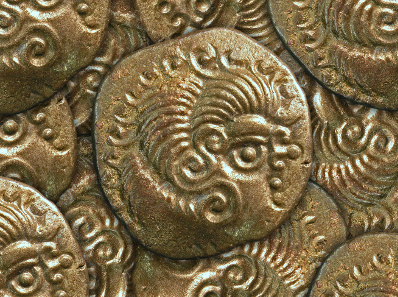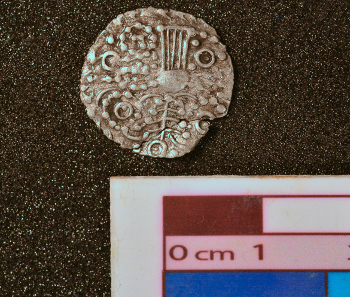July 3, 2014 – In what promises to be a very evocative, informative and unique exhibition, the world’s largest hoard of Celtic coins will go on display this year at the Jersey Museum as the centrepiece of a display that tells the fascinating story of northern France and the Channel Islands more than 2,000 years ago.
Detail of coins from the hoard.
The Le Catillon II hoard was discovered by metal detectorists Reg Mead and Richard Miles in 2012. Reg Mead had been searching for the coins for more than 30 years after being told of their existence by a ‘farmer’s wife’. The coins, which are still in a solid mound of clay as they were when they were gingerly lifted from the soil, are thought to number more than 70,000.
They are in one solid mass measuring 140 x 80 x 20cm – weighing three quarter of a ton. The coins are of Armorican origin (modern day Brittany and Normandy) from a tribe called the Coriosolitae, who were based around Rance in the area of modern-day St Malo and Dinan.
New items are being found continuously. This coin discovered on 2 June 2014 changed the date burial of the hoard from 50 BC to 40 BC.
They were thought to date from the year 50BC (Late Iron Age) but a recently found coin shifted this date to 40 BC. At this time the armies of Julius Caesar were advancing north-westwards through France, driving the tribal communities towards the coast. Some of them would have crossed the sea to Jersey, finding a safe place of refuge away from Caesar’s campaigns. The only safe way to store their wealth was to bury it in a secret place.
The hoard will be placed in a glass fronted ‘lab’ in the centre of the exhibition, with conservators working to carefully deconstruct the treasure to reveal the secrets that lie within. It takes the conservator on average 6 minutes to clean, photograph and log each coin. They are stored in a protective environment and the British Museum is being consulted about how best to undertake the conservation work. As well as the coins, the hoard is known to include items of precious metals and the public will be able to watch as its mysteries unfold.
The exhibition, titled ‘Treasure: Uncovering Celts and Romans’ and sponsored by Lloyds Bank, looks at the close cultural and economic links between the Channel Islands and France at the time of the Roman occupation of Gaul. Other items on display include artefacts from a Roman chariot burial in Normandy, and timbers from a Gallic-Roman galley that caught fire and sank in St Peter Port harbour (Guernsey). The timbers were discovered by a scallop diver in the early 1980s and have been housed by the Mary Rose Trust in Portsmouth, where they have been carefully conserved. It will be the first time they have gone on public display.
Jon Carter, Director of Jersey Heritage said, “This is a bold and innovative exhibition of some of the finest artefacts from the Roman – Celtic era. Together they tell a fascinating story of life in this area 2,000 years ago. Of course the coins are the centrepiece and we are very excited about what the hoard might yield, but it is important to put those coins in context and with the help of colleagues in Guernsey and France we have been able to do that.”
Tim Cooke, Chairman of Lloyds Bank International Ltd said, “Lloyds Bank is delighted to be involved in supporting this unique exhibition. We value our vibrant partnership with Jersey Heritage and will be working very closely with them on combined initiatives to bring this exhibition to the local community and also help to raise awareness internationally.”
The hoard is the property of the Crown, represented in Jersey by the Receiver General. They are in the care of Jersey Heritage.
The exhibition is officially opened on June 3rd and runs until the end of December.
You can find plenty of material on the hoard and the exhibition on the Jersey Heritage website.
The conservator’s blog may be of particular interest to you.






